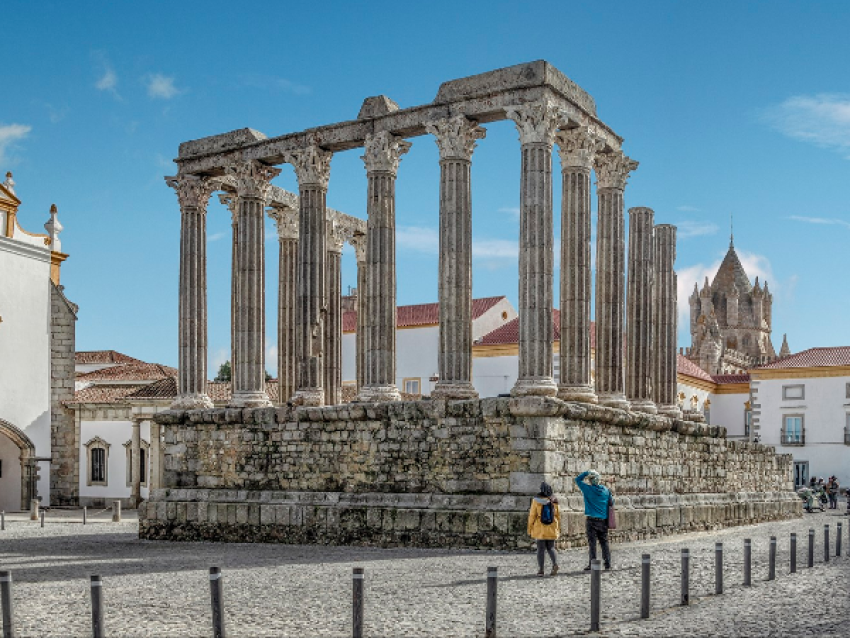

Stay : On the UNESCO World Heritage Trail in Alentejo, Portugal
The Alentejo is a region with a rich history dating back thousands of years. Its landscapes, architectural heritage and culture are unique and exceptional. Numerous places and art forms have been declared World Heritage Sites by UNESCO. The Festas do Povo de Campo Maior, the clay figurines of Estremoz, and the chocalheira, an art form characteristic of Alcáçovas, which consists of making cowbells that are unique in the world, are all part of humanity's intangible cultural heritage.
To be included on UNESCO's list of World Heritage sites, a place or site must be a unique monument of special cultural or physical importance that stands out geographically or historically. It can also recognize an outstanding achievement of humanity.
Let's discover UNESCO World Heritage sites in the Alentejo region.
Summary of the stay
Possible departure at these times
How to get there?
OFFICE DU TOURISME DE LA RÉGION ALENTEJO
7 days
From 1400 € to 2100 €
Detail of the stay : On the UNESCO World Heritage Trail in Alentejo, Portugal - 7 days

Day 1: Evora
Steps: Évora
Évora is a museum city with such a rich history that the entire town has been declared a UNESCO World Heritage Site. It was founded before the Roman occupation and reached its golden age in the 15th century. Its unique character comes from its whitewashed houses decorated with azulejos and wrought-iron balconies dating from the 16th, 17th and 18th centuries. Other attractions include a Roman temple, an imposing cathedral, casas pintadas, a university built in the 16th century and the unique Praça do Giraldo square.
Day 2: Les Festas do Povo de Campo Maior
Steps: Campo Maior
The Festas do Povo in Campo Maior, near Portalegre, have been part of UNESCO's Intangible Cultural Heritage of Humanity since December 2021. These traditional festivities are renowned for their tradition of adorning dozens of streets in the town's historic center with thousands of paper flowers handmade by local residents. Months in advance, Campo Maior residents fashion the paper decorations to transform their respective streets into a field of flowers. In this Alentejo town, the festival only takes place when the citizens decide to do so by voting.
Day 3: Elvas
Steps: Elvas
Elvas is a fortified city perched on a hill. The walls enclose narrow cobbled streets and a majestic cathedral overlooking a lively central square. The city, just a few kilometers from Spain, features star-shaped fortifications dating back to the 17th century, whose 10 km (6-mile) perimeter is the largest in the world. The city, heavily fortified from the 17th to the 19th century, boasts the world's largest system of ramparts and dry ditches. Within its walls are barracks and other military monuments, as well as churches and convents. The castle, the forts and the majestic Amoreira aqueduct, 7 km (4 miles) long, are part of UNESCO's World Heritage List.
Day 4: Estremoz and his clay figurines
Steps: Estremoz
Estremoz has been known since the 16th century for its clay figurines, which represent various members of the community as well as certain regional traditions. These delicately crafted and painted statuettes are recognized by UNESCO. The evolution of Estremoz figurines began when the story of Christ was told through a diorama of the Nativity. Non-religious figurines then emerged as an art form in their own right, telling local stories. They depicted shopkeepers, villagers and street vendors, before moving on to symbolic representations, such as the idea that "love is blind". These little clay marvels are the result of a week-long production process. The various parts of the figurine are first assembled before being fired in a ceramic kiln.
Day 5: Le rattle
Steps: Viana Do Alentejo
Alcáçovas and the chocalheira
Chocalheira is a characteristic art form of Alcáçovas and an intangible cultural heritage of humanity. Cowbells are handcrafted from cold-formed iron, bent on an anvil to a cup shape. Small pieces of copper or tin are fixed around the iron base and wrapped in a mixture of clay and straw. These ancestral bells produce an unmistakable sound, and carved out a place for themselves in the region's soundscape over 2,000 years ago.
Day 6: Le cante alentejano
Steps: Serpa
The cante alentejano is a two-part song traditionally performed by farm workers, characterized by distinctive melodies without musical accompaniment. Once used by shepherds to locate their livestock, it creates an easily recognizable soundscape in rural areas. The stories these songs tell are so beautiful that they have found their way into the ears (and hearts) of people the world over, becoming part of humanity's intangible cultural heritage. I invite you to come and listen to the soul of the Alentejo.
You can also find Cante in local cafés and associations, or at the new Museu do Cante (Cante Museum) in Serpa.
https://www.visitalentejo.pt/fr/blog/les-terres-musicales-de-l-alentejo/
Day 7: The art of falconry
Steps: Salvaterra De Magos
The noble art of falconry is on UNESCO's register of intangible cultural heritage. This relationship between man and bird, one of the oldest on Earth, is showcased every day at the Royal Falconry de Salvaterra de Magos, whose magnificent 18th-century architecture is as spectacular as the interaction with the falcons. Some of the birds of prey housed at the Royal Falconry have been criss-crossing the skies since the Middle Ages. The spectacle is as breathtaking today as it was then.
Ideas for holidays and week-end breaks Portugal
-
Find a hotel
-
Car Rental
-
-5% on travel insurance-15% off travel insurance
-
Find a local agency





